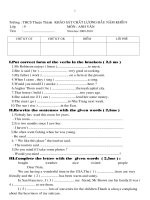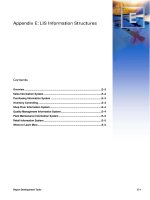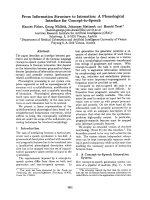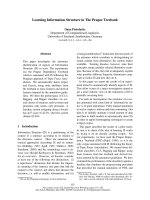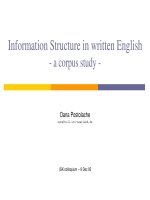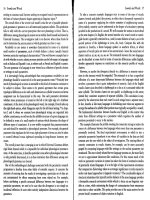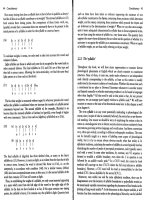English information structure
Bạn đang xem bản rút gọn của tài liệu. Xem và tải ngay bản đầy đủ của tài liệu tại đây (126.42 KB, 18 trang )
GRADUATE ACADEMY OF SOCIAL SCIENCES
ACADEMIC WRITING
Đặng Nguyên Giang, PhD
RECOMMENDED BOOKS
Gall, D., Borg, W.R. & Gall, J.P. (1996). Educational Research: An
Introduction. New York: Longman.
Hennessy, B. (1994). How to Wriite an Essay. Plimbridge House.
Howard, R. M. (2011). Writing Matters: A Handbook for Writing and
Research. McGraw-Hill Humanities/Social Sciences/Languages.
Jordan, R. R. (1990). Academic Writing Course. Longman ELT.
Menasche, L. (1997). Writing a Research Paper. Michigan: The
University of Michigan Press.
Murray, N. & Hughes, G. (2008). Writing up Your University
Assignments and Research Project. Open University Press.
Oshima, A. & Hogue, A. (2006). Writing Academic English (4th
Edition). Pearson Longman.
Spencer, C.M. & Arbon, B. (1997). Foundations of Writing. Illinois:
National Textbook Company.
White, R. & McGovern, D. (1994). Writing. New York: Prentice Hall.
AN INTRODUCTION TO ACADEMIC WRITING
Questions for discussion
1. What is academic writing?
2. What are the key characteristics of academic
writing?
3. What are the types of academic writing?
1. Academic writing is the formal writing style used in colleges and
universities. It’s what students are expected to produce for classes
and what professors and academic researchers use to write
scholarly materials.
2. Key characteristics of academic writing
• formal tone - A formal tone is always used in academic writing. It is
not lighthearted or conversational in tone. Slang and clichés do not
belong in this type of writing.
•precise language - In keeping with the formal tone, it’s important
to choose precise language that very clearly conveys the author’s
meaning.
•point-of-view (POV) - Academic writing is usually written in third
person POV because its focus is to educate on the facts rather than
to support an opinion or give advice.
•research focus - Because most academic writing involves reporting
research results, it tends to focus on the specific research
question(s) being studied.
•organization - Academic writing should be organized logically in a
linear, matter-of-fact fashion. Use headings to delineate each major
section.
•source citations - Most academic writing includes at least some
secondary research sources. Be sure to properly cite all sources and
include a bibliography.
3. The four main types of academic writing are descriptive,
analytical, persuasive and critical. Each of these types of
writing has specific language features and purposes.
- The simplest type of academic writing is descriptive. Its
purpose is to provide facts or information.
- Most academic writing is also analytical. Analytical
writing includes descriptive writing, but also requires you
to re-organise the facts and information you describe into
categories, groups, parts, types or relationships.
- Persuasive writing has all the features of analytical
writing (that is, information plus re-organising the
information), with the addition of your own point of view.
- Critical writing has all the features of persuasive writing,
with the added feature of at least one other point of view.
While persuasive writing requires you to have your own
point of view on an issue or topic, critical writing requires
you to consider at least two points of view, including your
own.
STUDY OUTLINE
1. Writing a sentence
2. Writing a paragraph
3. Writing an essay
4. Writing a master thesis proposal in English language
5. Writing a master thesis in English language
6. Referencing (APA style)
WRITING A SENTENCE
Questions for discussion
1. What is meant by “a sentence”?
2. What is meant by “an independent clause”/“a
dependent clause”?
1. According to Oxford English Dictionary (2nd edition)
(1989), “A sentence is a set of words that is complete in itself,
typically containing a subject and predicate, conveying a
statement, question, exclamation, or command, and consisting
of a main clause and sometimes one or more subordinate
clauses”. Oshima and Hogue (2006) suppose that sentences
involve clauses.
In short, a sentence is a word or a group of words
grammatically expressing a complete thought.
2. An independent clause is formed with a subject and a verb
and often a complement.
A dependent clause is formed with a subordinator, a subject,
and a verb.
WRITING A SENTENCE
Questions for discussion
3. How many basic kinds of sentences are
there in English? What are they?
4. What groups of words are used to connect
clauses in order to form different kinds of
sentences?
3. According to Oshima and Hogue (2006), there are four
kinds of sentences in English: simple, compound, complex,
and compound-complex.
4. They are subordinators (subordinating conjunctions),
coordinators (coordinating conjunctions), and conjunctive
adverbs.
after
although
as
as if
as soon as
because
for
and
accordingly
besides
consequently
for example
before
even though
how
if
since
so that
SUBORDINATORS
that
when
though
whenever
unless
where
until
wherever
what
whether
COORDINATORS
nor
but
or
CONJUNCTIVE ADVERBS
furthermore
in contrast
meanwhile
hence
indeed
moreover
however
instead
nevertheless
in addition
likewise
nonetheless
which
while
who
whom
whose
yet
so
on the other hand
otherwise
therefore
thus
WRITING A SENTENCE
Questions for discussion
5. What is meant by “a simple sentence”/ “a
compound sentence”/ “a complex sentence”/
“a compound-complex sentence”?
BASIC KINDS OF SENTENCES
- A simple sentence is one independent clause.
e.g. A school of birds are flying in the deep blue
sky.
- A compound sentence is two or more
independent clauses joined together. There are
three ways to join the clauses: with a
coordinator, with a conjunctive adverb, and with
a semicolon.
e.g. “Education is not preparation for life;
education is life itself.” - John Dewey -
- A complex sentence contains one independent
clause and one (or more) dependent
clause(s). A complex sentence can be built
with adverb clauses, adjective clauses, and
noun clauses.
e.g. If each kiss were a drop of water, I would
give you the sea.
- A compound complex-sentence has at least
three clauses, at least two of which are
independent.
e.g. When you once asked me “which do you
love more, me or life?”, I said “life”, and you
left me without knowing that you were my life.
NOUN CLAUSES
That clauses
If/Whether Clauses
Question clauses
ADVERB CLAUSES
Time clauses
Place clauses
Distance clauses
Frequency clauses
Manner clauses
Reason clauses
Result clauses
Purpose clauses
Contrast clauses
Concession (unexpected result) clauses
Conditional clauses
Kinds of adverb clauses
Time clauses
Examples
I want to travel around the world as soon as I graduate from
university.
Place clauses
Anywhere you go, you hear people taking on their mobile phones.
Distance clauses
Frequency clauses
She wants to follow me as far as I can go.
I do not visit my parents as often as they would like me to.
Manner clauses
Reason clauses
You can type these quotations as they appear in the manuscript.
He was an influential writer because he persuaded many people to
see the truth of his ideas.
The meeting ends since there is no more to be said.
As Peter is late for school, his mother has to apologize to his
teacher.
Result clauses
Purpose clauses
The cake was so hard that the children couldn’t eat it.
She worked hard so that everything would be ready at 6 o’clock.
Contrast clauses
English is understood all over the world, whereas Turkish is spoken
by only a few people outside Turkey itself.
Concession (unexpected result) Although I had studied all night, I didn’t pass the exam.
clauses
Conditional clauses
Unless you work hard, you won’t pass the exam.
Adjective clauses
Participial phrases
A pedestrian who had been hit by a A pedestrian hit by a speeding taxi was
speeding taxi was lying in the street. lying in the street.
An ambulance that was summoned An ambulance summoned
by a bystander came quickly.
bystander came quickly.
by
a
The taxi driver, who did not realize The taxi driver, not realizing what had
what had happened, continued on.
happened, continued on.
